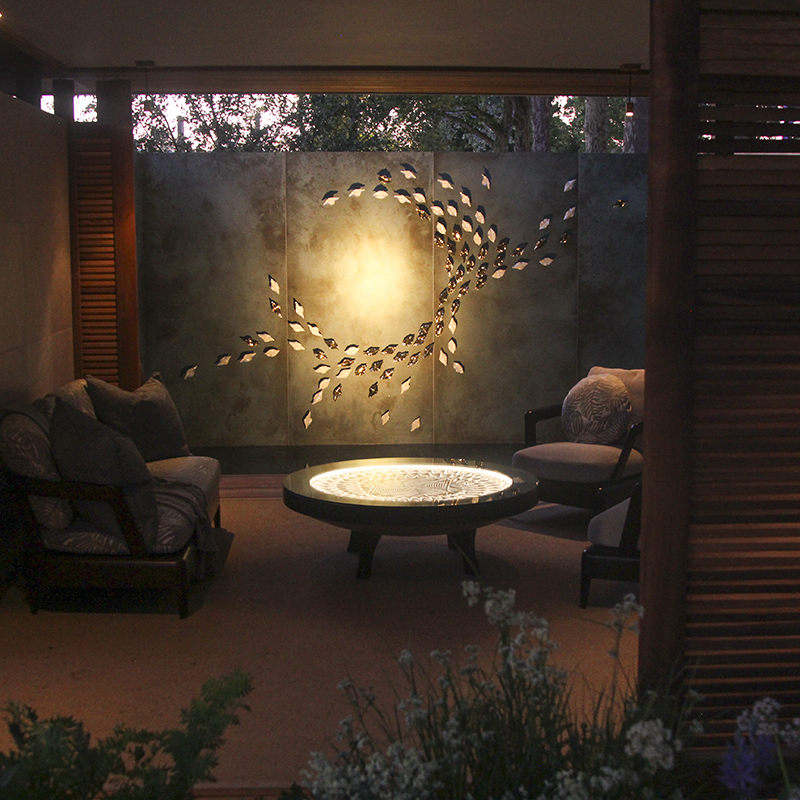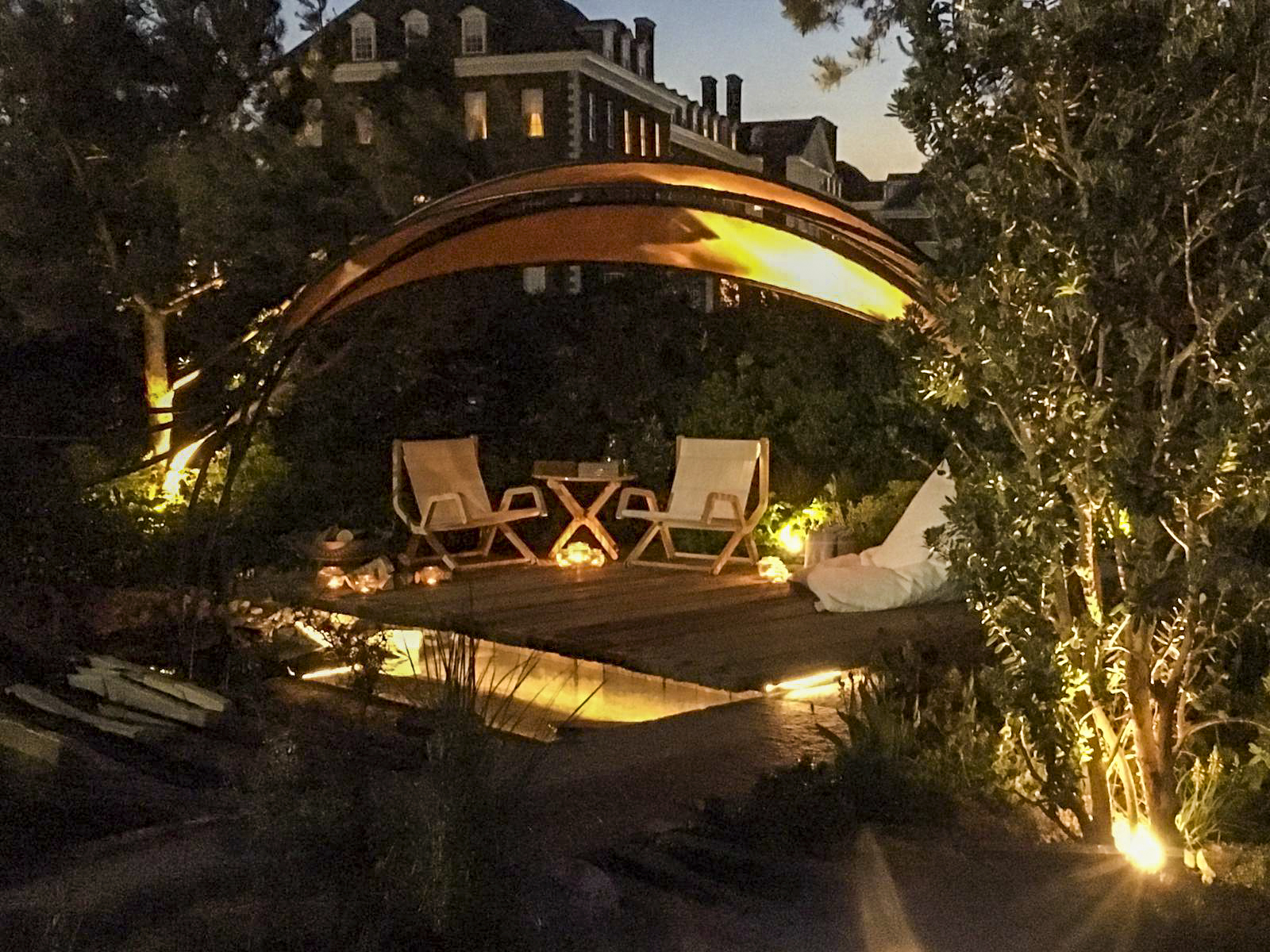Spotlight on garden lighting
Practical advice on designing and installing garden lighting from one of the UK’s leading landscape suppliers. Sam Cox from Landscapeplus shares his expertise.
Do you ever feel like you’re expected to be an expert on everything from planting to porcelain, construction to CAD, and legislation to lighting? We all know that feeling far too well and that’s why it’s never been more important to surround yourself with professionals that you can call on, trust and that you enjoy working with!
I most definitely do not see myself as an expert of planting, porcelain or construction for that matter but I like to think that I know a thing or two about Garden Lighting!

The Morgan Stanley Garden for the NSPCC designed by Chris Beardshaw
Like all things, Garden Lighting might seem daunting at first with so many options available within the market. I’m sure we all find ourselves confused, doubting ourselves and not sure where to start with frequent questions such as…
- What finish should I use…?
- How many fittings do I need…?
- How bright is that going to be…?
- What’s an IP rating? Lumen? Kelvin?
At Landscapeplus we’ve been answering these questions for the past 20 years. With the restrictions of the ongoing pandemic leaving many of us working in isolation from home, our very own Paul Willavoys has been somewhat of a caged animal. Having spent recent years ‘on the road’ visiting customers, colleges and cluster groups giving both design and practical training, he didn’t want the fun to stop!
The Landscapeplus Design Support Service…
We’ve found that booking one-on-one Zoom or Skype meetings early in your design process provides the opportunity to share screens, look at drawings, discuss the requirements for the garden, the client’s wishes, and budget then produce a quote – all within one conversation. This approach not only enables you to discuss the lighting, we can also help with water features or irrigation systems too and it’s completely FREE!

Show-stopping lighting at the RHS Chelsea Flower Show in 2019. This is The Facebook Garden: Beyond The Screen, by Joe Perkins Design
To give you a headstart, below are our 5 top tips to developing a successful lighting design.
1. Always LED.
Not so long ago a lighting system would often start with trenching armoured cable around the garden looping into junctions boxes (JB’s) and then to mains power (240v); feeding halogen light fittings that are far from environmentally friendly and would be rather hot in no time – not to mention the headache of lamps blowing. However, with the constant development of LED’s we can become much more environmentally friendly and reduce running costs amongst many other benefits. LED’s are without a doubt the only way to go!
2. Planning.
As with most things, it’s important to plan your scheme as early as possible. A simple conduit plan is a must and will always pay off once installed as the last thing you want is to lift hard materials to lay cables.
3. LED colour or temperature (kelvin)
. Ensuring all of your LED’s are the same colour is key to a good-looking consistent lighting scheme, as in my opinion mixing colours is tricky to make look good. 99% of the lights we sell are ‘warm white’, usually between 2700k – 3000k.
4. Quality and function over price
.
From time to time we’re all guilty of presuming that the most expensive must be the best, however, this is not always the case. Price can often be a good guide but with outdoor lighting, it’s much more important that the fitting is ‘fit for purpose’. A good starting point is to check the IP (ingress protection) rating of the fitting, for example, an IP68 fitting is fully submersible however an IP44 fitting is only protected against splashing water. As always, if in doubt just ask.
5. Don’t neglect the ugly stuff.
A common misconception is that a failed outdoor lighting system is down to the light fitting, as often (if the fitting is fit for purpose) it’s down to the infrastructure behind the fitting that can then cause the system to fail. Likewise, even the best quality fittings will not withstand a substandard infrastructure. We’ve listed a few simple points below that can help ensure your system works for years to come.
Practical considerations
- Waterproof connections: We always suggest adhesive lined heat-shrink tubing and potted/gel filled connections to keep any moisture out of the internals of the system.
- Conduit: Not only will a good conduit plan make installation much easier but we also recommend it to help protect your low voltage cables from any damage.
- Outdoor power supplies/transformers: Make sure that your power supplies (drivers) or transformers are fit for outdoor use, as if not they are guaranteed to cause issues before long. We always suggest potted (resin filled) IP67 units.
- Cable length: It’s always important to know the cable distances of your system as trying to run too far on the low voltage side of a transformer could result in voltage drop and therefore flickering lights. Voltage drop is less of an issue with a constant current system as they generally start with higher voltage but it’s always best to check. Our general rule of thumb is usually 10m for a 12v transformer and 50m from a constant current power supply.
Want to know more?
Get in touch, email [email protected] or call 01666 577577 – Just remember that Landscapeplus are strictly trade-only.
Best Trade Price – Professional Product – Direct to You
Enjoy more guest blogs on the My Garden Design Website
Horticultural Consultant Neville Stein offers advice on how to sell a garden design service
Alan Sargent discusses the importance of an accurate site survey





